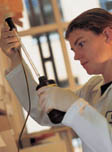 Mixing
and matching "That's where the future of cancer treatment lies - guiding the choice of therapy using a patient's molecular profile. In the next three to five years, we'll have a much better idea of the role that certain genes play in cancer development." Understanding these pathways also helps rule out drugs that may not be helpful. In research published last year in the journal Clinical Cancer Research, Gumerlock found that cell cycle modulators do not work well in patients with muta- tions of Rb, a tumor suppressor gene found in retinoblastoma that is also implicated in 15 percent of cases of non-small cell lung cancer. "So if you have non-small cell lung cancer with Rb mutations, you shouldn't take these drugs because they'll just make you sick." In a way, Gumerlock's role is that of chief theoretician for his lab. He looks at how cancer cells react to different agents and generates hypotheses about why they do what they do, then test them using the latest drugs. "We know what these drugs do in normal cells," he says. "We're studying how abnormal- ities in tumor cells affect apoptosis." The end result, Gumerlock hopes, is better medicine for a disease once synonymous with death - a disease scientists like him are deconstructing, molecule by molecule.
Home |
Table of Contents |
To our Readers |
Building on Basics UC Davis Health System | © 2000, 2001, 2002 UC Regents. All rights reserved. |
Medical student Lisa Moisan mixes solutions to create a gel that will separate cellular proteins according to size. |

